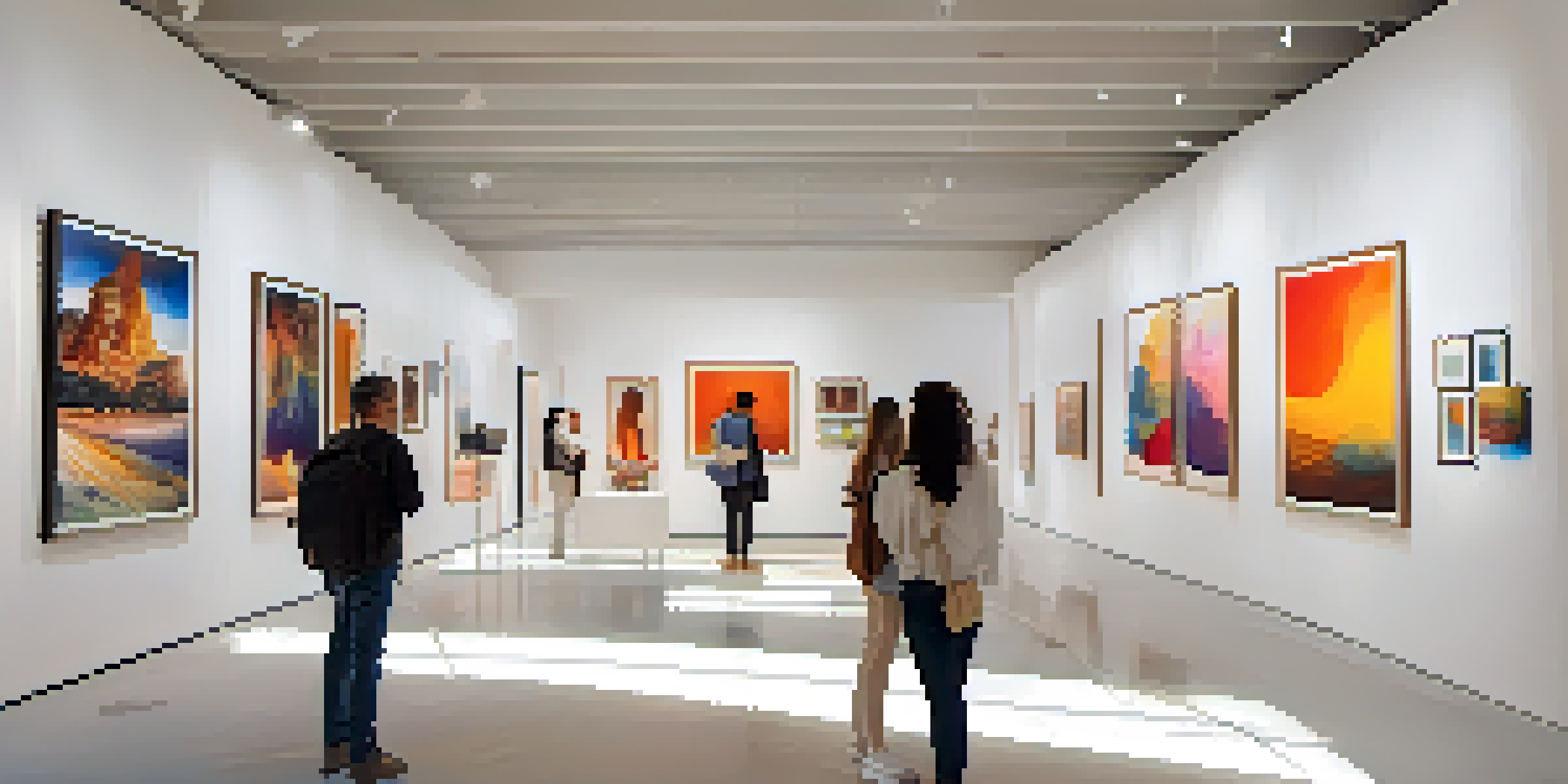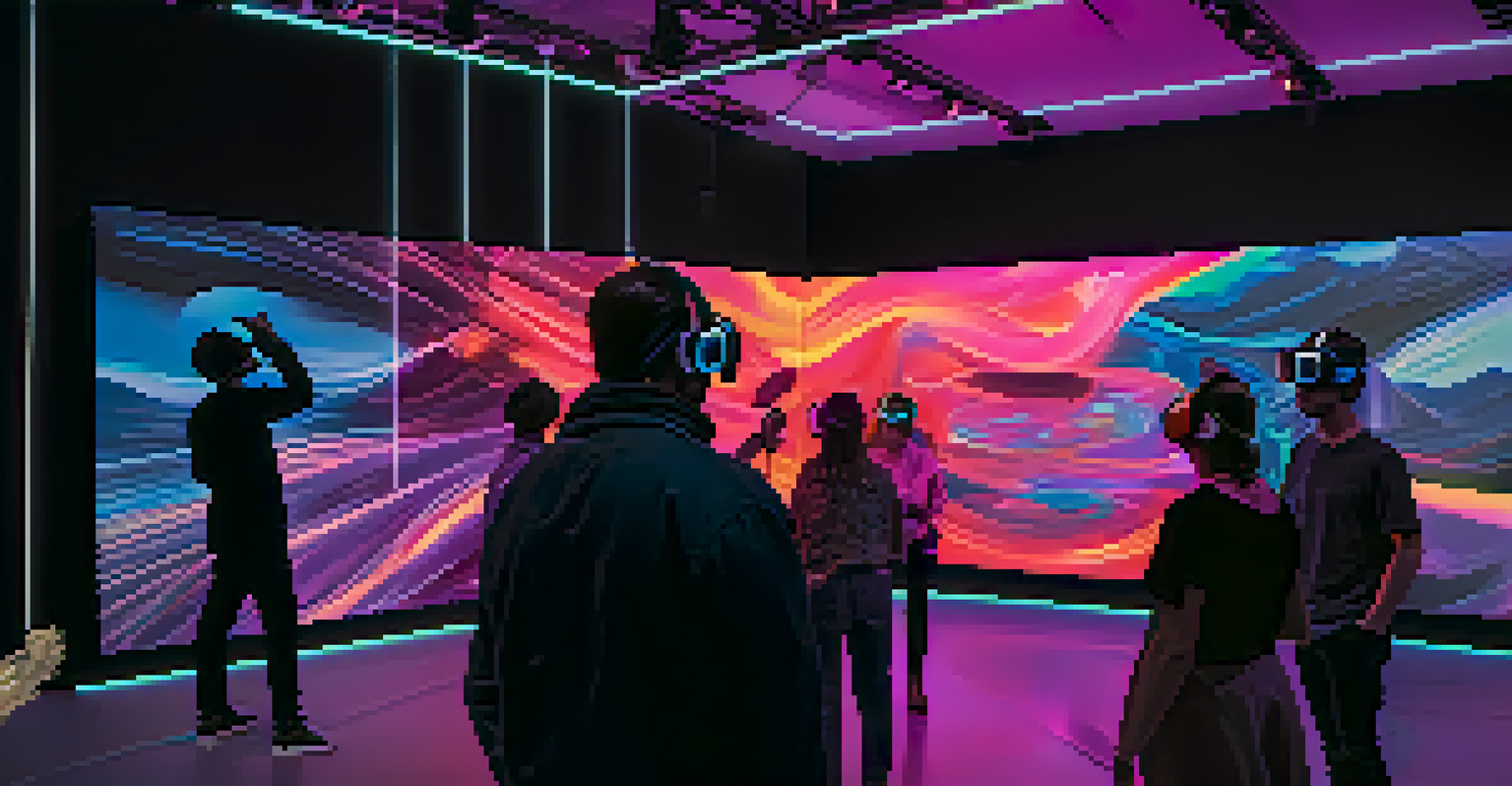Digital Art Platforms: Revolutionizing Art Distribution

Understanding the Rise of Digital Art Platforms
In recent years, digital art platforms have surged in popularity, offering artists a new avenue to showcase their work. These platforms provide an easy way for creators to share their art with a global audience, breaking down geographical barriers. With just a few clicks, artists can upload their pieces and connect with potential buyers around the world.
Art is not what you see, but what you make others see.
The rise of social media has played a significant role in this trend, allowing artists to build their brands and engage directly with fans. Platforms like Instagram and TikTok have given artists a visual showcase, creating a buzz around their work and driving traffic to their digital portfolios. This shift has empowered artists to take control of their art distribution, leading to new opportunities and collaborations.
Moreover, the accessibility of digital tools means that aspiring artists can create and share their work without the need for expensive galleries or traditional exhibition methods. This democratization of art distribution fosters a diverse range of voices and styles, enriching the art community as a whole.
How Digital Art Platforms Work
Digital art platforms function as online galleries where artists can upload their work for display and sale. These platforms often feature user-friendly interfaces that allow for easy navigation, making it simple for both artists and buyers to interact. When an artist uploads their piece, they typically include details such as title, description, and pricing, providing potential buyers with all the necessary information.

Additionally, many platforms offer social features that enable users to like, share, and comment on artworks. This interactivity not only enhances the user experience but also helps artists gain visibility and feedback. For instance, a piece that resonates with viewers may go viral, significantly boosting an artist's exposure and sales.
Digital Art Platforms Expand Reach
These platforms allow artists to showcase their work globally, breaking geographical barriers and increasing exposure.
Another key aspect of these platforms is their payment processing systems, which streamline transactions for both artists and buyers. Artists can receive payments quickly and securely, allowing them to focus more on their creative endeavors rather than administrative tasks.
Benefits for Artists Using Digital Platforms
One of the most significant advantages of digital art platforms is the increased exposure they provide. Artists can reach audiences far beyond their local communities, tapping into a global market eager for fresh, innovative art. This wider reach can lead to increased sales and greater recognition, which is vital for any artist’s career.
The best way to predict the future is to create it.
Moreover, these platforms often feature built-in marketing tools that help artists promote their work. From email newsletters to social media integrations, artists can leverage these resources to enhance their visibility and connect with potential customers more effectively. For instance, an artist can create targeted ads to reach specific demographics, increasing the likelihood of sales.
Additionally, digital platforms often foster a sense of community among artists. Many platforms encourage collaboration and networking, allowing artists to connect with one another, share ideas, and support each other's work. This camaraderie can be invaluable, especially for those just starting their artistic journeys.
The Role of NFTs in Art Distribution
Non-fungible tokens (NFTs) have emerged as a game-changing element in the digital art world, adding a new layer of authenticity and ownership. Unlike traditional digital files that can be easily copied, NFTs provide a unique digital certificate that verifies ownership. This innovation allows artists to sell their work in a way that was previously impossible, creating a new revenue stream.
Through NFTs, artists can also retain royalties on future sales of their work, ensuring they benefit from its appreciation over time. This feature not only incentivizes artists to create high-quality pieces but also fosters a more sustainable art market. For example, if a digital artwork is resold, the original artist receives a percentage of that sale, creating ongoing financial support.
NFTs Enhance Ownership and Value
Non-fungible tokens provide unique ownership verification for digital art, enabling artists to earn royalties on future sales.
However, the NFT landscape is still evolving, and artists must navigate various platforms and marketplaces to find the right fit for their work. While the potential for profit is high, it’s essential for artists to educate themselves about the technology and associated costs to make informed decisions.
Challenges Faced by Digital Artists
While digital art platforms offer numerous benefits, they also present challenges that artists must navigate. One major concern is the saturation of the market; with so many artists vying for attention, it can be difficult to stand out. This competition necessitates that artists continuously innovate and engage with their audience to maintain visibility.
Moreover, the digital nature of these platforms means that artists must be savvy about protecting their intellectual property. Copyright infringement can be a significant issue, with artworks being unlawfully copied or sold without permission. Artists need to take proactive measures, such as watermarking their images and understanding their rights, to safeguard their creations.
Lastly, the technology behind digital platforms can be intimidating for some artists. Not everyone may be comfortable navigating online tools or understanding the complexities of NFTs and blockchain technology. Therefore, having access to educational resources and support can be crucial in helping artists thrive in the digital landscape.
The Future of Digital Art Distribution
As technology continues to advance, the future of digital art distribution looks promising. We can expect to see further integration of virtual reality (VR) and augmented reality (AR), providing immersive experiences for viewers. Imagine being able to walk through a virtual gallery from the comfort of your home or visualizing how a piece would look in your own space before purchasing it.
Additionally, as more artists embrace the digital realm, we may witness the rise of new platforms that cater to specific niches or styles, further diversifying the market. This specialization can help artists find their target audience more effectively, creating tailored experiences for both creators and collectors.
Challenges in a Saturated Market
Despite the benefits, artists face challenges like market saturation and the need for intellectual property protection.
Ultimately, the digital art landscape is continuously evolving, and staying informed about trends and technologies will be essential for artists looking to succeed. By adapting to these changes, artists can harness the full potential of digital platforms to showcase their talent and connect with a wider audience.
Conclusion: Embracing the Digital Art Revolution
Digital art platforms have undeniably transformed the way artists distribute their work, making it easier than ever to reach a global audience. With benefits like increased exposure, community support, and innovative technologies like NFTs, artists have a wealth of opportunities at their fingertips. However, it’s crucial to remain aware of the challenges that come with this new landscape.
As we look to the future, embracing digital tools and staying informed will be vital for artists who want to thrive in this ever-changing environment. By leveraging the resources available to them, artists can not only enhance their visibility but also foster a more sustainable and equitable art market.

In this digital age, the art community is more connected than ever, and artists have the power to shape their paths. By exploring and embracing these digital platforms, they can revolutionize not just their art distribution but the entire art world.